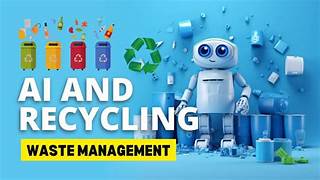The Use of AI in Improving Urban Waste Disposal Systems
Introduction
As urban populations continue to grow, the demand for more efficient and sustainable waste management systems has become one of the most pressing challenges in cities around the world. Cities are facing mounting pressures to not only manage the sheer volume of waste generated by residents, businesses, and industries but to do so in a way that minimizes environmental impact and maximizes resource recovery. Traditional waste disposal systems, while effective in many ways, often struggle to keep up with the complexities of modern urban living.
Enter Artificial Intelligence (AI)—a transformative technology that has the potential to revolutionize urban waste disposal systems. By integrating AI into waste management processes, cities can enhance the efficiency, sustainability, and cost-effectiveness of waste collection, sorting, recycling, and disposal. This article explores the various ways AI can improve urban waste disposal systems, from optimizing collection routes to advancing recycling processes, and even contributing to the development of circular economies.
1. AI-Powered Waste Collection Optimization
One of the primary challenges in urban waste management is efficiently collecting waste from millions of households and businesses. Traditional waste collection systems often rely on fixed schedules, leading to inefficient routes, delays, and missed pickups. However, AI offers a solution by enabling dynamic, data-driven optimization of waste collection routes.
1.1. Smart Waste Bins and Sensors
AI can be integrated with smart waste bins equipped with sensors that monitor the fill levels of the containers. These sensors provide real-time data on how full each bin is, allowing waste collection companies to plan routes more efficiently. Instead of following predetermined schedules or routes, collection trucks can be directed to bins that are near full, reducing unnecessary trips and fuel consumption.
For example, in a city with hundreds of waste bins, AI can process data from these sensors to determine the optimal sequence of bin pickups, minimizing the distance traveled and ensuring timely collection. This not only leads to cost savings but also reduces carbon emissions associated with waste collection.
1.2. Predictive Maintenance for Collection Vehicles
In addition to optimizing collection routes, AI can also play a key role in maintaining the vehicles used for waste disposal. AI-powered systems can monitor the health of waste collection trucks by analyzing real-time data from sensors embedded in the vehicles. This data can help predict when a vehicle requires maintenance, preventing costly breakdowns and ensuring that trucks remain operational for longer periods.
Predictive maintenance systems powered by AI can detect issues such as engine problems, tire wear, or even fuel efficiency issues before they become serious. By using machine learning algorithms to analyze historical maintenance data, AI can identify patterns and predict failures with remarkable accuracy. This reduces downtime, improves fleet management, and ensures a smoother waste collection process.
2. AI-Enhanced Waste Sorting and Recycling
Waste sorting is a critical step in the recycling process, but it is often labor-intensive and prone to errors. AI can significantly improve the efficiency and accuracy of waste sorting, increasing recycling rates and reducing contamination in recycled materials.
2.1. Automated Waste Sorting with AI and Robotics
AI-powered robots equipped with advanced sensors and machine vision can be used to sort waste materials more quickly and accurately than human workers. These robots can identify and separate different types of materials, such as plastics, metals, glass, and paper, based on their color, texture, and shape.
Machine learning algorithms enable these robots to continuously improve their sorting capabilities by learning from the materials they process. As the robots work, they become more adept at recognizing different items, even those that may be irregular or contaminated. This not only speeds up the sorting process but also reduces the risk of human error, ensuring that recyclable materials are not discarded with non-recyclable waste.
2.2. AI-Driven Material Recovery Facilities (MRFs)
Material Recovery Facilities (MRFs) are critical to the recycling process, but they often struggle with inefficiencies and high contamination rates. AI can help improve the operation of MRFs by optimizing the sorting of materials and ensuring that as much recyclable material as possible is recovered.
AI-powered systems can analyze incoming waste streams and automatically adjust the sorting process in real time to optimize for specific materials. For example, if a batch of waste is found to contain a high percentage of paper or plastic, the system can prioritize the sorting of those materials. Additionally, AI can assist in quality control by detecting contamination in recyclable materials and flagging it for removal.
By improving the accuracy of sorting, AI-driven MRFs can increase recycling rates, reduce the amount of waste sent to landfills, and provide higher-quality recycled materials that can be reused in manufacturing and production.
3. AI for Waste Disposal and Landfill Management
While recycling is a crucial component of waste management, a significant portion of waste still ends up in landfills. AI can play a key role in optimizing landfill management, improving waste disposal practices, and even reducing the environmental impact of landfills.
3.1. Smart Waste Monitoring and Management
AI can enhance landfill management by monitoring various factors such as waste composition, leachate levels, gas emissions, and landfill capacity. Using sensors and AI-powered analytics, landfill operators can obtain real-time data on the status of the landfill, enabling them to make informed decisions about waste disposal and treatment.
For example, AI systems can detect rising levels of methane gas—an important greenhouse gas emitted from landfills—and trigger automated responses such as activating gas extraction systems to prevent harmful emissions. Additionally, AI can help monitor the aging of waste in landfills, predicting when certain sections of the landfill may need to be capped or closed.
By integrating AI into landfill management, cities can ensure that landfills are operated more efficiently, safely, and sustainably, reducing their environmental impact.
3.2. Waste-to-Energy Technologies
AI can also enhance the efficiency of waste-to-energy (WTE) technologies, which convert waste into usable energy. WTE plants face challenges such as inconsistent feedstock quality and operational inefficiencies. AI can optimize the combustion process, ensuring that the waste-to-energy plant operates at maximum efficiency while minimizing emissions.
AI-powered systems can predict the optimal mix of waste materials to be fed into the incineration process, based on their calorific value and combustion characteristics. By analyzing historical data and real-time inputs, AI can help regulate temperature, air flow, and other variables in the combustion process to ensure that energy is extracted efficiently and sustainably.
Furthermore, AI can be used to monitor emissions and make adjustments to reduce the release of harmful pollutants into the atmosphere, ensuring that WTE plants operate in an environmentally responsible manner.
4. AI for Urban Waste Management Policy and Decision-Making
Beyond the operational aspects of waste management, AI can also support better policy-making and decision-making for urban waste disposal systems. By leveraging data from various sources, AI can provide city planners and policymakers with valuable insights into waste generation patterns, recycling rates, and the effectiveness of different waste management strategies.
4.1. Waste Generation Forecasting
AI can analyze historical data to predict future trends in waste generation, allowing cities to proactively plan for increases in waste volume. Machine learning models can analyze factors such as population growth, urban development, and economic activity to forecast waste generation in specific areas. This enables cities to allocate resources more effectively and plan waste collection and recycling operations accordingly.
4.2. Policy Simulation and Optimization
AI can also be used to simulate and optimize waste management policies. By analyzing the effects of different policy decisions, such as introducing new recycling programs or changing waste collection schedules, AI can provide valuable insights into the potential outcomes of these policies. This helps policymakers make data-driven decisions that lead to more efficient, cost-effective, and sustainable waste management practices.
5. Overcoming Challenges and Ethical Considerations
While AI has the potential to revolutionize urban waste management, its implementation does come with challenges. One major concern is the cost of integrating AI into existing waste management systems. Many cities, especially in developing regions, may not have the financial resources or infrastructure to adopt AI technologies at scale.
Moreover, there are ethical considerations related to data privacy and security. AI-driven waste management systems often rely on collecting vast amounts of data from sensors and cameras, which could raise concerns about surveillance and data misuse. Ensuring that data is collected and used responsibly will be crucial to maintaining public trust in AI-powered waste management systems.
Conclusion
The integration of AI into urban waste disposal systems holds immense potential for improving efficiency, sustainability, and cost-effectiveness. From optimizing waste collection routes to enhancing recycling processes and improving landfill management, AI offers innovative solutions to the complex challenges faced by cities around the world. As AI technology continues to evolve, its role in transforming urban waste management will only grow, leading to cleaner, more sustainable cities for generations to come.
This article highlights how AI is reshaping urban waste disposal systems, from collection to disposal, and emphasizes the need for careful implementation and consideration of ethical concerns. If you have any further questions or would like to explore specific aspects of AI in waste management, feel free to reach out.


